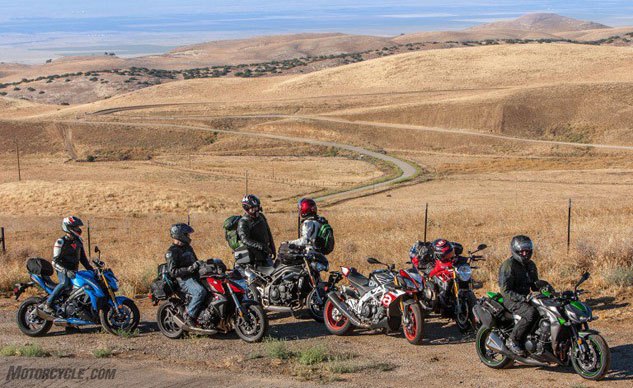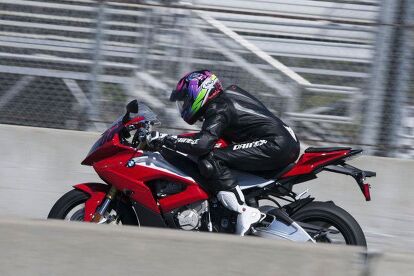What's The Best Motorcycle Engine: Twin, Triple or Four?
Ask MO Anything: How Many Cylinders Do I Really Need?
Dear MOby,
I have been an inline-Four man for the last 30 years. Recently I have had the opportunity to sample some Twins and three-cylinder machines. Whilst all the bikes sampled were naked with over 100 hp and similar to my personal ride, the most obvious difference I noted was a lack of weight with bikes of fewer cylinders.
Whilst power output would dictate size of components and corresponding weight, is it necessarily true more cylinders must equate to more weight? If one can obtain same power with a lighter and fewer-cylinder engine (probably larger displacement though), why bother with a multi? Where light is right, I am questioning my faith of the inline-Four.
René
Cyberspace
Motorcycle manufacturers and MOrons alike have been trying to answer the same question for over 100 years now. Basically what it comes down to, or used to come down to, is the more cylinders you have, the more power you can make. Splitting 1000cc, or any displacement, into four small cylinders means the engine can spin faster, potentially process more air and fuel by spinning faster, and make more power. That’s one reason why MotoGP bikes all have four cylinders lately: With their excellent traction (and riders), they need all the power they can get. Some of them might have more cylinders if the rules allowed it; Honda’s RC211V had five before the rules changed.
Stepping down one rung in the roadracing pecking order to World Superbike, however, shows us that Ducatis with two cylinders are also highly competitive, but only if they’re allowed to have 20% more displacement than the Fours. Still, a Ducati hasn’t won the WSBK championship since Carlos Checa did it in 2010. The last five years have been all Kawasaki and Aprilia Four-bangers.
Currently, it seems like all MotoGP bikes can make more power than tires and physics can handle; hence traction control, wheelie control, etc. Without electronics, we’d see many more high-side crashes – and the advances in materials and engineers’ brains mean those levels of power, reined in and subdued by sound and emissions regulations, have trickled down to our street machines. A BMW S1000RR won our Six-Way Superbike Shootout back in 2015, with the help of its class-leading 999cc four-cylinder spinning out 182.9 rear-wheel horsepower at 13,100 rpm. Given our usual rule of thumb that driveline losses in a chain-driven bike eat up about 10% of hp as power makes its way from crankshaft to rear wheel, the BMW is a true 200-hp motorcycle (BMW claims 199).
I, for one, would’ve refused to ride it around Laguna Seca without the electronic security blanket engaged, and I don’t think many street riders would ever spend much time at all at wide-open throttle on the BMW.
The same applies to the 1285cc Ducati Panigale 1299S which was in the same shootout and pumped out 175 horses at 10,400 rpm – but would probably be even more challenging to ride without its electronics thanks to its massive torque output: 92.5 pound-feet at 8900 rpm to the BMW’s measly 79.9 at 9600 rpm.
Around Laguna Seca, every pound matters, and the BMW weighs 451 pounds gassed up – 24 pounds more than the Ducati. With a 160-pound rider, then, the BMW has a horsepower-to-weight ratio of 3.338 hp-per-pound to the Ducati’s 3.354 hp/lb. In technical terms, we refer to that as “a wash” – but of course there’s more to it than power-to-weight unless you’re only going in a straight line. When it’s time to turn, the lighter motorcycle has the advantage. Meanwhile, the bike we called the winner was the 175.8-hp, 456-lb, 1000cc V-Four Aprilia RSV4: 3.503 lbs per hp.
Ranked by Power-to-Weight Ratio… | |||||
|---|---|---|---|---|---|
| Bike | Wet weight | Horsepower | Torque in Pound-feet | Lbs/HP w 160-lb rider | Lbs/Lb-ft w 160-lb rider |
| BMW S1000RR inline Four | 451 | 182.9 | 79.7 | 3.338 | 7.647 |
| Ducati 1299 Panigale S V-Twin | 427 | 175.0 | 92.5 | 3.354 | 6.345 |
| Aprilia RSV4 V-Four | 456 | 175.8 | 76.7 | 3.503 | 8.031 |
| EBR 1190 SX V-Twin | 449 | 156.0 | 83.0 | 3.903 | 7.337 |
| BMW S1000R inline Four | 459 | 155.3 | 79.7 | 3.986 | 7.766 |
| KTM Super Duke R V-Twin | 469 | 156.0 | 96.5 | 4.032 | 6.518 |
| MV Agusta F3 800 Triple | 420 (estimated) | 133 (estimated) | 58.0 (estimated) | 4.360 | 10.000 |
| Triumph Speed Triple Triple | 478 | 124.2 | 76.1 | 5.136 | 8.383 |
| Yamaha FZ-09 Triple | 419 | 106.2 | 59.7 | 5.46 | 9.698 |
If we’re talking more streetable sportbikes, there are even more excellent options, a couple of our favorites being the KTM Super Duke R (which just got remodelled this year) and the BMW S1000R. Last time we got them in a room together, the Super Duke R won (and was our 2014 Motorcycle of the Year), but it was a near thing. The KTM made 156 hp at 9100 rpm, the BMW 155.3 hp at 11,200 rpm. Like the Ducati, the KTM was a terribly grunty thing, producing 96.5 lb-ft at 8200 rpm to the BMW’s 79.7 at 9500 rpm.
On the official MO scales, the BMW registered 459 lbs, the KTM 469, for power-to-weights of 3.985 and 4.032 lbs/hp respectively. Then there’s the Buell EBR 1190 SX Twin, which is lighter than the BMW Four at just 449 lbs. With 156 hp, it has a p/w ratio of 3.903. These bikes are all nipple-inverting fast.
When the tachometers are wound all the way up, there’s not much in it between Four and Twin, but at a less all-out pace, the Twins do produce more midrange torque that seems to propel them along with less gearshifting; it’s kind of a matter of what you like.
If we rank our nine contestants in order of best Pounds-per-Lb-ft of Torque, we get: Panigale, Super Duke R, EBR 1190, S1000RR, S1000R, Aprilia RSV4, Speed Triple, FZ-09 and MV Agusta – which is almost exactly the same thing as ranking them in order of engine displacement. (If I’d included the Aprilia Tuono 1100, which is 1077cc, it would’ve finished ahead of the BMWs.)
We love Triples too, but since no factory’s trying to race one lately, there’s no really light, powerful naked version to trickle down. The closest are the Triumph Speed Triples, which use a 1050cc engine to produce 124.2 horses at 8900 rpm. At 478 pounds (with our 160-lb rider), they’re pushing 5.136 lbs per hp; 76.1 lb-ft of torque makes the Speed Triple feel faster, but in this crowd it’s neither lightest or fastest. It’s still ridiculous fast.
Wait, there is one factory trying to race a Triple, and it’s MV Agusta and its World Supersport contender F3 675. Jules Cluzel won two races on it and finished second in the WSS championship last season (other 675s finished 7th and 8th; three out of 10 ain’t bad for a tiny Italian company). Lucky for us, there’s a stroked, 800cc version of that Triple MV rates at 148 hp and 381 pounds dry. Add 26 pounds of gas, give MV the benefit of the doubt, reduce claimed power by 10% and you’re looking at a torquey Triple in the 420-lb range: a p/w of 4.36 isn’t far off the literbikes. The Brutale naked version we rode here is rated at just 116 hp, but it also feels plenty fast. At the rear wheel, that should be about par with the Yamaha FZ-09, whose 847cc Triple put out 106.2 horses last time we dynoed one, and weighed a wispy 419 lbs: 5.46 lbs/hp.
Sorry for blathering on, but the point is, yes, buy what you like the sound of! The Twins and Fours are neck and neck in terms of speed and weight, with a few expensive outliers, and the Triples aren’t far behind, especially if you go shopping in the middleweight class. Some would argue that the only thing that sounds better than a Twin or Triple is a Twin or Triple turning a bunch of rpm…
Why are there no MV Agustas in my garage?
Direct your motorcycle-related questions to AskMoAnything@motorcycle.com, though some say we’re better at non-motorcycle-related ones…
More by John Burns


































Comments
Join the conversation
I prefer thumpthing lighter and simpler.
I like the smooth power delivery of an inline four but a healthy dose of low and midrange grunt that twin cyl's offer, is much more important for street riding.
An inline three must be a good compromise. I have yet to ride one.
Liking the Yamaha three banger and the three banger MV is sex on two wheels.